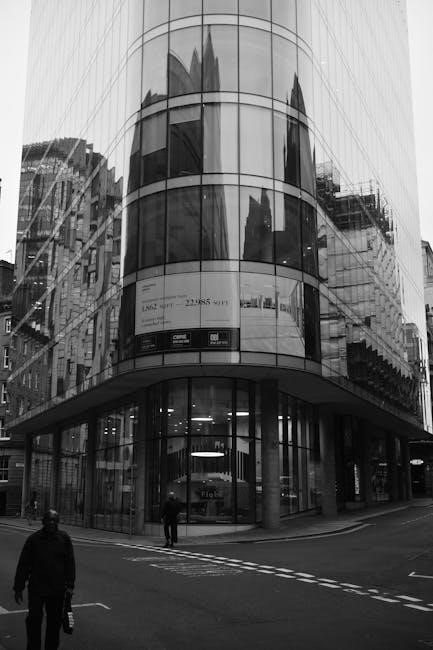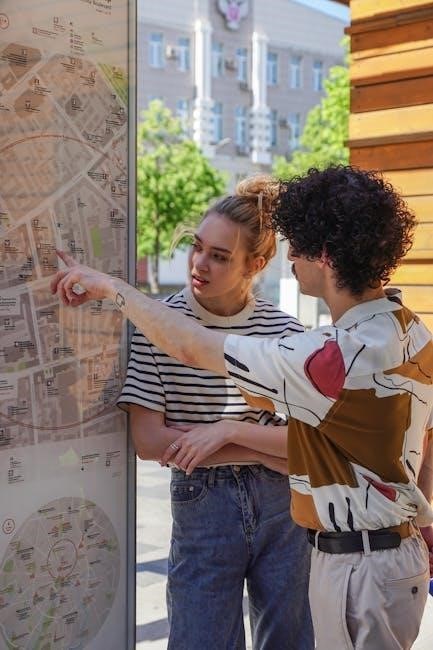Edinburgh City Centre is a historic and vibrant area, offering cultural attractions, walkable streets, and efficient public transport. PDF maps provide detailed layouts, highlighting key landmarks and routes for visitors.

Overview of Edinburgh’s Geography and Layout
Edinburgh City Centre is nestled in the southeastern part of Scotland, characterized by its unique blend of medieval and modern architecture. The city’s geography is marked by its Old Town, with narrow, winding streets, and the New Town, featuring broad, grid-like layouts. The Royal Mile, a historic spine of the Old Town, connects Edinburgh Castle to the Palace of Holyroodhouse. Arthur’s Seat, an ancient volcano, offers stunning views and is part of Holyrood Park, a sprawling green space within the city. The city’s layout is divided by the North Sea to the east and the Pentland Hills to the south, creating a compact yet diverse urban environment. Maps of Edinburgh City Centre highlight these geographical features, making navigation easier for visitors exploring its rich cultural and historical landmarks.
Importance of Mapping Edinburgh City Centre
Mapping Edinburgh City Centre is crucial for both residents and visitors, as it aids in navigating the city’s intricate layout. The city’s narrow medieval streets can be confusing, making maps essential for locating key attractions like the Royal Mile and Edinburgh Castle. PDF maps provide a comprehensive overview, highlighting pedestrian zones, public transport routes, and cultural landmarks. They are particularly useful for tourists, offering insights into UNESCO World Heritage Sites and historical areas. Maps also assist in planning itineraries efficiently, ensuring visitors make the most of their time. Additionally, interactive online maps offer real-time updates, helping users avoid traffic and find the best routes. Overall, mapping Edinburgh City Centre enhances the overall experience, making exploration seamless and enjoyable for everyone.
Historical Context of Edinburgh City Centre
Edinburgh’s history is reflected in its architecture and layout, with the Old Town and New Town showcasing medieval and Georgian influences. The Royal Mile and its landmarks highlight the city’s rich cultural heritage, while historical maps reveal its transformation over centuries.
Evolution of Edinburgh’s Architecture
Edinburgh’s architecture reflects its rich history, blending medieval, Georgian, and Victorian styles. The Old Town features narrow, winding streets with tenements like the Royal Mile, while the New Town boasts grand Georgian designs. The medieval era left landmarks like St. Giles’ Cathedral, whereas the 18th-century New Town added neoclassical symmetry. The Victorian period introduced ornate Gothic Revival designs, such as the Scott Monument. Modern developments integrate contemporary styles while preserving historic character. Historical maps, like the map of Edinburgh city centre PDF, reveal this architectural evolution, showcasing how the city has grown and adapted over centuries. This layered architectural heritage makes Edinburgh a unique and visually striking destination, with each era contributing to its distinctive skyline and cultural identity.
Key Historical Landmarks in the City Centre
Edinburgh’s city centre is home to a wealth of iconic historical landmarks that reflect its rich cultural and political past. Edinburgh Castle, perched atop Castle Rock, dominates the skyline and is one of Scotland’s most famous attractions. The Royal Mile, the historic main street of the Old Town, is lined with notable sites such as St. Giles’ Cathedral and the Scottish Storytelling Centre. The National Monument of Scotland on Calton Hill offers stunning views and commemorates Scotland’s fallen soldiers. These landmarks are strategically located and easily identifiable on a map of Edinburgh city centre PDF, making navigation simple for visitors. Each site provides a glimpse into Edinburgh’s vibrant history, from its medieval roots to its role as Scotland’s capital.

Transportation in Edinburgh City Centre
Edinburgh’s city centre features an efficient transport network, including buses, trams, and walking routes, all clearly marked on a map of Edinburgh city centre PDF for easy navigation.
Walking Routes and Pedestrian Zones
Edinburgh’s city centre is renowned for its walkable layout, with numerous pedestrian zones and scenic walking routes. The map of Edinburgh city centre PDF highlights these paths, showcasing the historic Royal Mile, a UNESCO World Heritage Site, as a central walking route. Pedestrian zones like George Street and Princes Street Gardens offer a car-free environment, perfect for exploring shops, cafes, and landmarks. The Old Town’s narrow cobblestone streets are also ideal for walking, with iconic sites like the National Museum of Scotland and Edinburgh Castle within easy reach. These routes are well-marked on downloadable maps, ensuring visitors can navigate the city’s charm effortlessly. Walking is not only the most accessible way to explore but also an eco-friendly option, aligning with Edinburgh’s sustainability goals.

Public Transport Options in the City Centre
Edinburgh’s city centre boasts an efficient public transport network, with buses and trams connecting key locations. The map of Edinburgh city centre PDF provides clear details of routes, stops, and interchange points. Lothian Buses operate extensively, covering areas like Princes Street, George Street, and the Royal Mile. The Edinburgh Trams network links the city centre to the airport and other suburbs, with stops at St Andrew Square and York Place. Both services offer real-time information and affordable fares. The PDF map also highlights night bus services, ensuring 24/7 connectivity. This well-organized system makes exploring the city centre convenient for residents and visitors alike, reducing reliance on private vehicles and promoting sustainable travel.
Bike Rentals and Cycling Paths
Edinburgh’s city centre offers excellent bike rental options and cycling paths, making it a cyclist-friendly destination. The map of Edinburgh city centre PDF highlights key bike rental locations, such as the popular Just Eat Cycle Hire scheme, with stations across the city. Cycling paths, including the Union Canal towpath and the Water of Leith Walkway, provide scenic routes for riders. The map also shows dedicated bike lanes on major roads, ensuring safe travel. Families and tourists can explore attractions like the Meadows and Holyrood Park via these routes. The PDF map is a valuable resource for planning cycling trips, showcasing Edinburgh’s commitment to sustainable and enjoyable transportation. With its well-marked paths and rental options, cycling is an ideal way to discover the city centre’s charm.
Parking and Traffic Management
Parking and traffic management in Edinburgh city centre are well-organized to accommodate both residents and visitors. The map of Edinburgh city centre PDF provides clear details about designated parking areas, including multi-story car parks and street parking zones. Key locations like the Old Town and city centre are marked with controlled parking zones to manage congestion. The map also highlights one-way streets and traffic restrictions, helping drivers navigate efficiently. Additionally, it identifies pedestrianized areas and traffic-free zones, such as the Royal Mile, ensuring safe access for all. Live traffic updates and real-time parking availability can be found through linked resources in the map, making it easier to plan visits. Edinburgh’s traffic management prioritizes sustainability, with initiatives like bus lanes and cycle-friendly routes. The PDF map is an essential tool for understanding the city’s parking and traffic flow.
Cultural and Tourist Attractions
The map of Edinburgh city centre PDF highlights iconic attractions like the Royal Mile, Edinburgh Castle, and the National Museum of Scotland. It also marks cultural hotspots, theaters, and art galleries, guiding visitors to historic landmarks and vibrant festivals. The map ensures easy navigation to UNESCO World Heritage Sites and hidden gems, making it indispensable for exploring the city’s rich cultural tapestry.

UNESCO World Heritage Sites in Edinburgh
Edinburgh’s Old and New Towns are UNESCO World Heritage Sites, showcasing the city’s rich architectural and cultural heritage. The map of Edinburgh city centre PDF provides detailed insights into these areas, highlighting landmarks like the Royal Mile, Edinburgh Castle, and Georgian New Town. These sites reflect Scotland’s historical and cultural evolution, with their unique urban landscape and preserved architecture. Visitors can use the map to explore these areas, gaining a deeper understanding of their significance. The UNESCO designation ensures these locations are protected, maintaining their authenticity for future generations. The map serves as an essential tool for navigating and appreciating these iconic districts, making it easier to plan visits and self-guided tours.
Museums and Galleries in the City Centre
Edinburgh’s city centre is home to a wealth of museums and galleries that cater to diverse interests. The map of Edinburgh city centre PDF provides a comprehensive guide to these cultural gems, such as the National Museum of Scotland, the Scottish National Gallery, and the Royal Scottish Academy. These institutions house world-class collections, from Scottish art and history to international masterpieces. The map highlights their locations, making it easy for visitors to plan their cultural itinerary. Many of these venues are within walking distance, allowing for a seamless exploration of the city’s artistic and historical treasures. The PDF map also includes information on opening times and special exhibitions, ensuring visitors can make the most of their experience in Edinburgh’s vibrant cultural scene.

Historical Churches and Cathedrals
Edinburgh’s city centre is adorned with iconic churches and cathedrals that reflect its rich spiritual and architectural heritage. The map of Edinburgh city centre PDF pinpoints these historic sites, such as St. Giles’ Cathedral, St. Mary’s Cathedral, and the Canongate Kirk. These landmarks, many dating back centuries, offer insight into the city’s religious history and cultural identity. The map provides detailed locations, allowing visitors to explore these sacred spaces effortlessly. St. Giles’ Cathedral, with its striking Gothic architecture, is a must-visit, while the nearby Church of Scotland’s Assembly Hall adds to the area’s historical charm. The PDF map also highlights walking routes connecting these sites, making it easy to embark on a self-guided historical tour of Edinburgh’s ecclesiastical gems.
Shopping Areas and Markets
Edinburgh’s city centre boasts a vibrant array of shopping areas and markets, making it a paradise for retail enthusiasts. The map of Edinburgh city centre PDF highlights key destinations such as the Royal Mile, Princes Street, and George Street, which are lined with boutiques, high-street brands, and souvenir shops. The historic Grassmarket is another hotspot, offering unique independent stores and weekend markets. Additionally, the Edinburgh Farmers’ Market at Castle Terrace provides fresh local produce and crafts, adding a touch of authenticity to the shopping experience. The PDF map ensures visitors can navigate these areas seamlessly, discovering everything from luxury goods to artisanal treasures. Whether you’re seeking high-end fashion or quirky souvenirs, Edinburgh’s shopping scene, as detailed in the map, has something for everyone.

Modern Developments in Edinburgh City Centre
Edinburgh’s city centre has seen revitalized mixed-use spaces, sustainable buildings, and tech-driven infrastructure. The map of Edinburgh city centre PDF highlights modern amenities and eco-friendly initiatives shaping its future.
Urban Renewal Projects
Edinburgh City Centre has undergone significant urban renewal projects, transforming historic areas into vibrant, modern spaces. The map of Edinburgh city centre PDF illustrates these developments, showcasing revamped districts like the Old Town and Cowgate. Initiatives focus on preserving heritage while introducing contemporary designs, such as the revitalization of George Street and the Royal Mile. These projects aim to enhance pedestrian accessibility, improve infrastructure, and integrate sustainable features. Green spaces and public art installations have been prioritized to create a more livable and aesthetically pleasing environment. The PDF maps highlight these transformations, offering insights into how Edinburgh balances its rich history with forward-thinking urban planning. These efforts not only boost the city’s appeal but also ensure its infrastructure meets the needs of residents and visitors alike.
Sustainable Development Initiatives
Edinburgh City Centre is a leader in sustainable development, with initiatives reflected in its urban planning and infrastructure. The map of Edinburgh city centre PDF highlights green spaces, such as Princes Street Gardens and The Meadows, which play a crucial role in reducing carbon emissions and improving air quality. The city has implemented energy-efficient lighting and waste reduction programs, aligning with its goal to become carbon neutral by 2030. Renewable energy sources, including solar panels on public buildings, are also prominent. The PDF maps illustrate cycling paths and pedestrian zones, promoting eco-friendly transportation. Additionally, Edinburgh’s sustainable development includes green roofs and rainwater harvesting systems. These efforts create a balanced urban environment, blending historical charm with modern eco-conscious practices, as clearly visualized in the PDF maps.
Technology and Smart City Solutions

Edinburgh City Centre is embracing smart city solutions to enhance urban living and visitor experiences. The map of Edinburgh city centre PDF showcases initiatives like smart traffic management systems, which optimize traffic flow and reduce congestion. Energy-efficient street lighting, powered by renewable sources, is highlighted on the map, contributing to the city’s sustainability goals. Digital information hubs and free Wi-Fi zones are marked, providing visitors with real-time updates on transportation, events, and local services. The city also integrates data analytics to improve public safety and waste management. These technological advancements, visible on the PDF maps, demonstrate Edinburgh’s commitment to becoming a smarter, greener, and more connected city. By leveraging technology, Edinburgh ensures a seamless and sustainable urban environment for residents and tourists alike.

Practical Information for Visitors

Welcome to Edinburgh City Centre! This section provides essential tips for visitors, including accommodation, dining, and safety, ensuring a smooth and enjoyable experience in this vibrant city.
Best Times to Visit Edinburgh
Edinburgh is a year-round destination, but the best times to visit are during spring (April–June) and summer (July–August). Summer offers mild weather and the iconic Edinburgh Festival Fringe, while spring provides vibrant blooms and fewer crowds. Autumn (September–October) is ideal for experiencing the city’s cultural vibe and enjoying the picturesque foliage. Winter (November–February) is quieter, with a magical festive atmosphere, especially during Christmas markets. For outdoor activities, summer is prime, but spring and autumn are perfect for walking tours. Be mindful of public holidays and festival dates, as attractions may be busier. Planning your visit with a map of Edinburgh City Centre PDF ensures you make the most of your time exploring this historic city’s hidden gems and popular landmarks.
Accommodation Options in the City Centre
Edinburgh’s city centre offers a wide range of accommodation options to suit all budgets and preferences. From luxury boutique hotels to cozy bed-and-breakfasts, and from modern apartments to historic guesthouses, visitors can find the perfect place to stay. Many hotels are located near iconic landmarks like the Royal Mile, Princes Street, and Edinburgh Castle, making exploration convenient. Budget-friendly options, such as hostels and budget hotels, are also plentiful, particularly in the Old Town. For those seeking elegance, the Georgian architecture of the New Town provides upscale accommodations. A map of Edinburgh City Centre PDF can help visitors identify the best locations for their stay, ensuring proximity to key attractions and transport links. Booking in advance is recommended, especially during peak festival seasons, to secure the most suitable option.
Local Cuisine and Dining Experiences
Edinburgh’s city centre is a culinary gem, offering a diverse range of dining experiences that cater to every taste and budget. The city is renowned for its fresh seafood, locally sourced produce, and traditional Scottish dishes such as haggis, neeps and tatties, and Cullen skink. Fine dining restaurants, cozy pubs, and charming cafes are scattered throughout the historic streets, providing a blend of traditional and modern flavours. A map of Edinburgh City Centre PDF is an excellent tool for locating these hidden gems, ensuring visitors can explore the city’s vibrant food scene effortlessly. From Michelin-starred eateries to intimate bistros, Edinburgh’s dining culture is as rich as its history, making it a must-visit destination for food enthusiasts. The city’s commitment to quality and sustainability shines through in its culinary offerings, offering something for everyone to enjoy.
Emergency Services and Safety Tips
Edinburgh is a safe city, but it’s always wise to be prepared. Emergency services, including police, ambulance, and fire departments, are readily accessible and can be located using a map of Edinburgh City Centre PDF. The city centre is well-patrolled, especially in popular tourist areas like the Royal Mile. For urgent assistance, dial 999 or 112. Non-emergency situations can be reported by calling 101 for police services. Visitors should be mindful of pickpocketing in crowded areas and keep valuables secure. Staying informed about local conditions and following safety guidelines can enhance your experience. Additionally, the city offers well-marked first aid points and public information booths. Familiarizing yourself with emergency service locations using a detailed map ensures peace of mind while exploring Edinburgh’s historic and vibrant city centre.
Digital Mapping Resources
Downloadable PDF maps of Edinburgh City Centre provide offline access to key locations, transport links, and landmarks. Interactive online maps offer real-time navigation, while GPS apps enhance exploration efficiency.
PDF Maps of Edinburgh City Centre
Official PDF maps of Edinburgh City Centre are widely available, offering detailed layouts of streets, landmarks, and public transport. These downloadable resources are ideal for offline navigation, ensuring visitors can explore without internet access. Many maps highlight key attractions, such as the Royal Mile, Edinburgh Castle, and Princes Street Gardens. They often include zoomable sections for clarity and are printable for convenience. Visitors can find these maps on Edinburgh’s official tourism websites, local council pages, or travel guide platforms. Some PDFs also feature interactive elements, like clickable points of interest. Whether planning a walking tour or locating hotels and restaurants, these maps provide essential information. They are particularly useful for first-time visitors unfamiliar with the city’s layout. Downloading a PDF map is a practical step to enhance your Edinburgh City Centre experience.
Interactive Online Maps and Guides
Interactive online maps and guides are indispensable tools for navigating Edinburgh City Centre. These dynamic resources, often available on Edinburgh’s tourism websites or platforms like Google Maps, provide real-time updates and interactive features. Users can zoom in on specific areas, view street layouts, and explore points of interest such as restaurants, shops, and historical sites. Many platforms offer customizable routes for walking tours or public transport. Some interactive guides include user reviews, helping visitors make informed decisions about where to go. These tools are particularly useful for planning itineraries or discovering lesser-known attractions. They also cater to different preferences, such as filtering options for family-friendly spots or cultural landmarks. With their user-friendly interfaces and up-to-date information, interactive online maps and guides are essential for both tourists and locals exploring Edinburgh City Centre.
GPS Navigation and Mobile Apps
GPS navigation and mobile apps have revolutionized exploring Edinburgh City Centre, offering convenient and real-time guidance. Popular apps like Google Maps and Citymapper provide detailed street layouts, helping users find the quickest routes. These tools are especially useful for navigating Edinburgh’s historic streets and discovering hidden gems. Many apps include voice-guided directions, making it easier to explore on foot or by vehicle. Additionally, they often feature real-time traffic updates and public transport schedules. Some apps highlight points of interest, such as landmarks, restaurants, and shops, while others allow users to save favorite locations. With GPS-enabled devices, visitors can seamlessly navigate Edinburgh’s city centre, ensuring they make the most of their time. Mobile apps also offer offline maps, which are handy for areas with limited Wi-Fi or data coverage. These tools are essential for both tourists and locals alike, enhancing the overall experience of exploring Edinburgh.
Edinburgh City Centre is a must-visit destination, blending rich history with modern charm. Its unique architecture, vibrant culture, and scenic beauty captivate visitors, making it a timeless gem that embodies Scotland’s spirit.
Why Edinburgh City Centre is a Must-Visit Destination
Edinburgh City Centre captivates visitors with its rich history, stunning architecture, and vibrant cultural scene. The UNESCO World Heritage Sites, such as the Old and New Towns, showcase Scotland’s architectural brilliance. The city’s compact layout makes it easy to explore iconic landmarks like the Royal Mile, Edinburgh Castle, and the Scottish National Gallery. Festivals like the Edinburgh Festival Fringe bring the city to life, while its museums, galleries, and historical churches offer deep insights into its past. The diverse shopping areas, from traditional souvenir shops to modern boutiques, cater to all tastes. With its unique blend of history and modernity, Edinburgh City Centre is a destination that appeals to history enthusiasts, culture lovers, and shoppers alike, ensuring an unforgettable experience for all.
